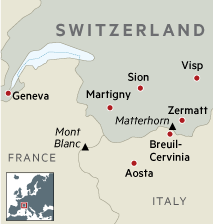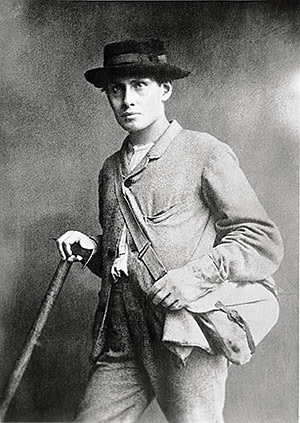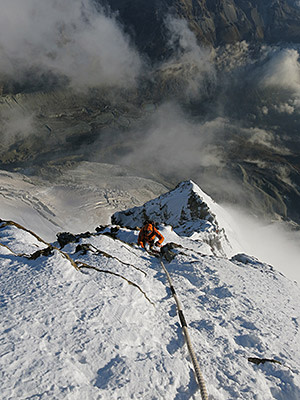Tragedy and triumph on the Matterhorn
Simply sign up to the Life & Arts myFT Digest -- delivered directly to your inbox.
Close to the top of the Matterhorn, the northeast ridge — known as the Hörnligrat — steepens into a final rocky tower. I had been looking at this challenge for an hour, wondering, as I inched up towards it, how it would go. It is spectacular but technically easier than it looks, or so I’d been told. Mountain guides from Zermatt, the town at the foot of the peak, have fixed strong ropes to help their clients get past this last obstacle more easily.
It can get crowded, though. There were slower climbers ahead of us so my guide, an affable Slovak called Michal Sekelsky, took me on an overtaking manoeuvre, traversing out on to the north face. I followed his lead, kicking in my crampons — then gulped. A dizzying void had appeared between my feet ending at the glacier far below. I was roped to Michal but if I made a mistake here, there would be little he could do. I would pull him off the face and we would both be gone.
This was more or less the place where, 150 years ago, triumph turned to tragedy for Edward Whymper, his three British climbing partners and three Alpine guides, just minutes after they had succeeded in becoming the first people to reach the summit.
The team were roped together when one of the British, a young novice called Douglas Hadow, slipped. He knocked over his French guide, Michel Croz, and their weight on the rope pulled off the next man, a 36-year-old country parson called Charles Hudson, and the fourth climber as well, Lord Francis Douglas, younger brother of the Marquess of Queensbury. Above him, the remaining three men dug in and the rope tightened — then snapped — leaving them to watch in horror as the bodies of their companions cartwheeled thousands of feet down the mountain.
It was a defining moment in the history of mountaineering; arguably as pivotal as the first ascent of Everest. Before this calamity climbing was a quirky minority pastime and Zermatt an indigent and obscure village. All that changed on July 14 1865. As locals now cheerfully acknowledge, the Matterhorn disaster enthralled the public around the world and sparked an unprecedented tourist boom.

Today, more tourists come to Zermatt than to any other resort in the Swiss Alps — some simply to play in the casino and enjoy the five-star hotels, others to test themselves in the surrounding peaks (typically 3,000 will attempt the Matterhorn each summer). At dinner one night during my stay, I found myself at the next table to Sir Richard Branson, in town to watch from a helicopter as his son Sam made his bid for the summit.
I had been invited here with a small band of writers from around the world as part of Zermatt’s drive to make the anniversary as big an international event as possible. This summer will see a season of performances based on Whymper’s story in a 700-seat open air theatre built high on the mountainside, alongside festivals, walking tours and exhibitions down in the town. The Hörnli hut, the mountain refuge from where Matterhorn climbers set off, has been refurbished and expanded to mark the occasion. And Zermatt is even hoping for an appearance of the British royal family (a guide was sent to Buckingham Palace last year with an invitation to Princes William and Harry to try to climb the Matterhorn). A huge clock in the Bahnhofplatz is already counting down the minutes to July 14.
. . .
A group of guides was waiting for us at Zermatt’s Gornergrat station. We paused as they took a moment to size us up, like the prelude to a gunfight. In Whymper’s era they couldn’t afford to turn down work. These days, no Swiss guide takes a client on the Matterhorn who isn’t capable of climbing it, let alone a complete novice such as Douglas Hadow. It’s one of the reasons fatality rates on the Matterhorn continue to fall.
The weather forecast was dismal and as the guides led us off to test us on some training climbs, they looked gloomy and shook their heads. It was September, near the end of the summer climbing season, but the mountain was cloaked in snow and ice and no more than 50 people had made it up all year. Our leader was Andreas Perren, whose grandmother was the granddaughter of Peter Taugwalder, one of Whymper’s guides. Taugwalder was left clinging to the mountain with his father, also a guide, and Whymper after the rope broke. Whymper reported at length their weaknesses in the immediate aftermath — how young Peter fell apart, how the old man asked about their wages. Such public criticism of men clearly in shock is still remembered with bitterness. Yet Zermatt’s story is forever intertwined with the obsessive Englishman who survived the catastrophe. In the weeks after the accident, Whymper found himself at the centre of a media frenzy. Imperial London was appalled at the news, particularly since Francis Douglas was a scion of an aristocratic family and just 18 years old.
Where, as the Times demanded, was the sense in it? “Why is the best blood of England to waste itself in scaling hitherto inaccessible peaks, in staining the eternal snow and reaching the unfathomable abyss never to return?” the paper demanded to know. “Is it duty? Is it common sense? Is it allowable? Is it not wrong?” Charles Dickens condemned mountaineering as a “greater folly than gambling” with “nothing to win but an empty boast”. Whymper himself was haunted by the accident, later writing that he continually relived it: “Every night . . . I see my comrades of the Matterhorn slipping on their backs, their arms outstretched. ”

Like Coleridge’s ancient mariner, he told and retold the story as though doing so would rid him of it. The press may have been critical but the public was captivated, and Whymper became the sport’s first major celebrity. His lectures were seen by tens of thousands and inspired Winston Churchill to visit Zermatt (though he was kept off the Matterhorn by his anxious tutor.) Thomas Hardy was so gripped by Whymper’s account that he wrote a poem about it. Scrambles Amongst the Alps, Whymper’s own book, was published in 1871 and became one of the classic texts — “There is no book which has sent more climbers to the Alps,” wrote Sir Arnold Lunn, the skier, mountaineer and writer.
Whymper was a very different kind of mountain hero from George Mallory, the British Everest pioneer, but just as compelling. A Lambeth boy, he grew up with the stench of south London in his nostrils and a fear of poverty.
As a young man, he wrote in his diary: “How I should like to be a lawyer but I suppose I never shall.” Instead, he was needed for the family engraving business, providing illustrations for the publishing trade. Commissioned to do a series of sketches for the publisher William Longman, he set out as a 20-year-old to sketch the Alps, covering huge distances on foot and falling in with the obsessive “scramblers” of the Alpine Club at Zermatt.
In those days — the early 1860s — Zermatt was alpinism’s world centre and the Monte Rosa Hotel the unofficial clubhouse of the newly formed Alpine Club. All around are summits that were first climbed by its members, an eccentric but intellectually powerful elite. Leslie Stephen, for example, the Victorian man of letters and father of Virginia Woolf, was first up the elegant spire of the Zinal Rothorn. John Tyndall, the pioneering physicist, bagged the Weisshorn just to the north.
To be absorbed into this grand company was thrilling for Whymper, upward social mobility of the most literal kind, and the Matterhorn should have been his crowning glory. Instead he found himself back at the Monte Rosa, exhausted and distraught, to raise the alarm.
It is still a hotel today, filled with climbing memorabilia. Standing outside on Bahnhofstrasse, mingling with the shoppers and tour groups from China and Japan, you can’t help but gaze up at the Matterhorn. At 4,478m, it’s not the highest peak in the Alps, and it’s not the hardest — it achieves its primacy by its magnificent isolation and elegant structure. Wherever I walked in town, I would turn around and find the peak watching me.
The Hörnli ridge, as the guides kept reminding us, is mostly a long but easy rock climb, so we spent the days leading up to our ascent proving we could go at a reasonable pace. The longer you’re on the mountain the more tired you get and the more likely you are to make a mistake, so Perren had me scrambling down facing outwards — scary, but much more efficient.
Among our knot of guides, greyhounds all, was the diminutive figure of Andreas Steindl, sleek and purposeful. In August 2011 he left Zermatt, ran to the base of the Hörnli ridge and climbed to the summit in just 2hr 57m. That’s a height gain of almost 3,000m, over a distance of five and a half miles, yet when I asked him about it, Steindl just rolled his eyes — such things are routine now in Zermatt, where a clutch of young Swiss stars are pushing back the boundaries of speed climbing. Whymper himself was no slouch. He prided himself on his walking speed and stamina, leaving Lambeth one day to walk to Portsmouth in 20 hours without rest.
Miraculously, as our week progressed, the weather improved and the guides announced themselves content to try. Late in the afternoon on the eve of our attempt, we caught the cable car up to Schwarzsee and walked in the shadow of the mountain to the temporary camp set up at the base of the ridge while the Hörnli hut was being renovated. It was a freezing and windy night and I expected the guides to cancel, but at 3.30am I found myself shouldering my rucksack and stepping out behind Michal.
. . .

Scrambling upwards, I used the light from my head-torch to seek out each foothold, but the darkness was comforting too, cloaking the growing void beneath us. By 6.30am, dawn was approaching and we’d reached the Solvay hut, a tiny emergency shelter at 4,000m. We had come two-thirds of the way in three hours and Michal seemed happy to continue. We fastened crampons to our boots and pressed on.
Above the hut we reached the crest of the Hörnli ridge and were exposed to a biting wind as we tiptoed up its snowy apex, the north face below us and above the steepening final section of the summit block. For the first time since I arrived in Zermatt, I began to believe I might make it. The climbing was straightforward but the space beneath me felt immense.
Fifteen minutes after we passed the site of the tragedy, Michal and I arrived at the top, passing the spooky little statue of St Bernard rooted to the summit rocks. It had been a bitterly cold ascent. When I took a glove off to work the camera, my fingers froze and still tingled a fortnight afterwards.
The view was worth it. Threads of mist hung in the valleys. Small pools thousands of feet below glittered in the sunshine like jewels set in black rock. Looking up, the Monte Rosa massif filled the eastern horizon, white skirts billowing, the Gorner glacier sweeping round it in an elegant train.
I was exultant, bursting with joy and deeply grateful to Michal. We hugged each other. The world seemed tremendous and beautiful. And yet I knew we were only halfway home; echoing through my thoughts was Whymper’s haunting imprecation: “Climb if you will, but remember that courage and strength are naught without prudence, and that a momentary negligence may destroy the happiness of a lifetime. Do nothing in haste; look well to each step; and from the beginning think what may be the end.
Could I climb the Matterhorn?
How dangerous is it?
Relatively inexperienced climbers regularly reach the Matterhorn’s summit, giving rise to a myth that it is easy — and safe. In fact, more than 500 people have died on the peak (almost double Everest’s toll), which makes it by far the deadliest in Switzerland. In 1990, the 125th anniversary of the ascent by Whymper, 14 people died, but the death rate has since fallen, thanks to better weather forecasting and helicopter rescue techniques, and the fact that more climbers now hire guides. Since 2010, the average annual death toll has been fewer than three.
Am I capable?
Climbers do not need advanced technical skills but should be fit and have experience of scrambling and using crampons and ice axes. Guides work on a one-to-one basis and lead the way, using a rope to secure their client. From the Hörnli hut the climb takes between four and six hours, the descent about the same.
How do you arrange a guide?
Local guides can be hired for the climb through the Zermatt Alpin Center (alpincenter-zermatt.ch) in the centre of the village; the climb costs SFr1,215 (£837), plus about SFr300 to cover accommodation at the Hörnli hut.
Alternatively, several guiding companies run week-long courses that start with several days of training and acclimatisation, ending with the ascent. A week’s course with Mountain Tracks (mountaintracks.co.uk) costs £2,525.
Details
For full details of 150th anniversary events in Zermatt see zermatt.ch. Ed Douglas was a guest of the Swiss tourist board (MySwitzerland.com) and Swiss International Air Lines (swiss.com). Swiss flies direct to Zurich from 45 countries; returns from London, Birmingham or Manchester from £115. Swiss Transfer Tickets cost £104 and cover a return train and bus trip from any airport or border crossing to any destination in the country, see swisstravelsystem.co.uk
Photographs and slideshow photographs: Alex Messenger; Zermatt tourismus
Comments